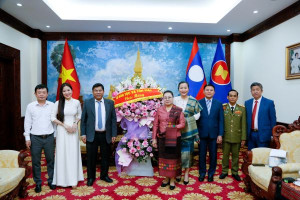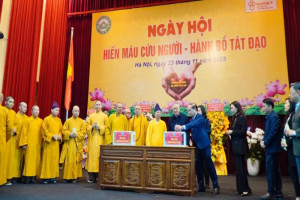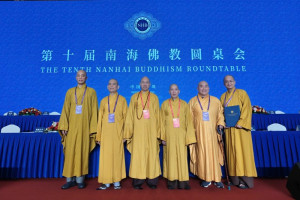
At the beginning of the twentieth century, the colonial regime and the Nguyễn feudal court reinforced their exploitation and oppression of the Vietnamese people.
Working people became more and more miserable, and their lives grew increasingly impoverished. This was particularly true of the Southern peasants who lost their land and were forced to work as serfs for landlords. The failure of the people’s struggle and the hopeless attitude towards the present life led to a spiritual crisis. In addition, the decay of popular religion and contemporary social values created a large gap in spiritual needs.

The Cao Dai Tây Ninh Holy See, Tây Ninh province
During this period, the Western Theosophy Movement became very popular in the South through such forms as "xây bàn" (the turning table), which resembles Vietnamese seance customs, and "cầu cơ" (evocation of a Superior Spirit) by the Five Branches of the Bright Way Sect (Ngũ chi Minh đạo). This brought about a movement, cầu cơ và chấp bút (spiritual seance and written record), called “cơ bút” for short, referring to the mechanism for a spiritual seance). Two main groups among those engaging in spiritual seance (đàn cơ) contributed to the formation of the Cao Dai religion. The first group led by Ngô Minh Chiêu conducted cầu cơ at temples and pagodas in the traditional way of cơ bút and the Five Branches of the Bright Way. The second group led by Cao Quỳnh Cư, Cao Hoài Sang, and Phạm Công Tắc first conducted their turning table and seances according to Western theosophy for entertainment, but afterwards they used the Minh Thiện (belonging to the Five Branches of the Bright Way) spiritual seance.
On 7 October 1926, a group of 28 Vietnamese representing 247 believers signed the “Declaration of the Founding of the Cao Dai Religion” and sent it to the French Governor of Cochin China. In the middle of November 1926 (15th day of 10th month of the Year of the Tiger), the first disciples of the Cao Dai religion organized their inauguration ceremony at Gò Kén Pagoda, Tây Ninh province in Southern Vietnam and officially declared the foundation of the Cao Dai religion.
The principle of the Cao Dai religion is “Three religions returned to their same origin – Five Branches are reunited". The doctrine of the Cao Dai religion dignifies the Divine and the miraculous quality of Supreme Spirits and considers them as the means for human beings to unify with God. “The New Canonical Codes” (Tân luật) and the “Religious Constitution of the Cao Dai Religion” (Pháp Chánh truyền) maintain the religious laws and rules. Cao Dai ceremonies are rather sophisticated and complicated because they reflect the spirit of “three religions originating from the same source". Cao Dai followers worship the Divine Eye, meaning the Eye of Heaven and a symbol of the Supreme Being of the Cao Dai religion. Worshipping protocol divides into three levels: The Holy See (Tòa thánh), the Holy House or Oratory (Thánh thất or Thánh tịnh), and the Private House (Tư gia).
The Cao Dai religion is organized into three branches: The Eight Trigram Palace (Bát Quái đài), which is the secluded branch and worships the Supreme Being (the Divine Eye), the Buddha, the Immortal, the Saints, and the Genies; the Heavenly-Union Palace (Hiệp Thiên đài) is the legislative body and has the authority to set up and manage the spiritual seances; it monitors the activities of the Nine Spheres Palace (Cửu Trùng đài) headed by the Maintainer of Rules and Laws (Hộ pháp). The executive body (Cửu Trùng đài) consists of nine ministries and is headed by a pope (Giáo tông).
Between 1926 and 1934, after the declaration of foundation, Cao Dai leaders advanced their missionary work in the South so that the Cao Dai religion became a domestic religion. They embraced the spirit of patriotism and thoroughly used the mysteriousness of their apparatus for spiritual seances (cơ bút) to attract followers. The leaders concentrated on building the Holy See, promoted the Holy Houses and oratories, and improved the religious doctrine, laws, ceremonies, and organization, thus helping to consolidate and stabilize the activities of the Holy See and to develop grassroots establishments. The body of the religious administration began to take shape on five levels from the center to the grassroots. During this period, the practice of the Cao Dai religion was conducted mainly through spiritual seances. Several dignitaries exploited the spiritual seances to compete for influence. This led to contradiction between the Heavenly-Union Palace and the Nine Spheres Palace. Discord in the Sacerdotal Council caused some senior disciples to disagree with the Holy See and leave for different localities, where they established their own Cao Dai sects.
The period between 1934 and 1975 witnessed not only the robust development of the Cao Dai religion but also saw the separation of the Cao Dai religion into different independent sects, sometimes as many as 30. The number of followers reached about two million, most of them living in the South and a small number scattered in several Northern and Central provinces.
After 1975, Cao Dai sects were organized differently compared with the previous organizational structure of the Cao Dai religion. They are now administered by the Church Council at the central level and the parishes at the grassroots level. From 1995 to 2000, nine Cao Dai sects carried out their plenary congresses to approve their charters, a two-level administration system, and three councils: The High Council (Thượng hội), the Sacerdotal Council (Hội thánh), and the Popular Council (Hội Nhơn sanh). They adopted the following motto: “The Nation is glorious, the Way enlightens” (Nước vinh, Đạo sáng).
At present, central and provincial authorities have granted legal recognition of the following Cao Dai sects: The Ante-Creation (Cao Dai Tiên Thiên) Church; the Bright-Verity Way (Cao Dai Minh Chơn Đạo) Church; the Cao Dai Dazzling Bright (Chiếu Minh Long Châu) Church; the Cao Dai Missionary (Truyền giáo) Church; the Cao Dai Church of Tây Ninh Province; the Cao Dai Correct Path (Ban Chỉnh đạo) Church; the Cao Dai White Cloth (Bạch y) Church; the Cao Dai Verity (Chơn lý) Church; the Cao Dai Prayer at the Three-Door Temple Gate (Cầu Kho Tam Quan) Church; The Vietnam Cai Dai (Binh Duc) Church; Cao Dai Practising sect of Dazzling Bright Invisible (Phap mon Cao Dai Chieu minh Tam thanh Vo vi); and more than 20 independently-operated oratories.
During resistance wars against foreign aggression, a majority of leaders and adherents of the various Cao Dai sects actively assisted the revolution and contributed their efforts and wealth to the cause of national liberation and unification. Today, Cao Dai followers actively take part in Vietnam’s Reform and Renewal and national defense and construction.




